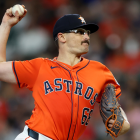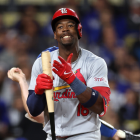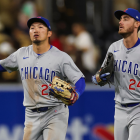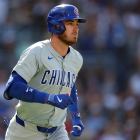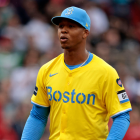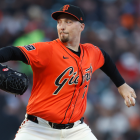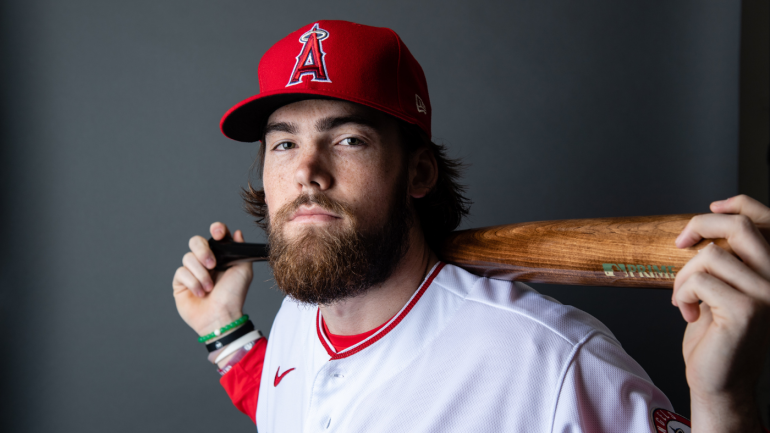
The arrival of the offseason means that it's time to rank stuff. Already this winter, we've sized up the 60 best free agents, both on an overall and positional basis. There's no law that prevents us from ranking minor-league players in addition to their big-league counterparts. As such, we're going to spend the winter evaluating every team's farm system.
The lack of a minor-league season makes that more of a challenge this year. It doesn't help that some teams opted against sharing video and data from their alternate-site camps with the rest of the league. As such, we've opted against overthinking this. Our rankings will essentially be the same as they were last winter with a few changes. First, we'll exclude anyone who graduated by exhausting their rookie eligibility; second, we'll replace them with draftees or other worthy prospects; and third, and lastly, we'll present the information in a new format.
In every article in this series, you'll find a team's top five prospects as well as five others we felt like including, either because of their promise or some other reason. For those top five prospects, you'll find a quick summation of their pros (their saving grace, if one will) and their cons (their fault line), as well as beefier report and our attempt to peg their "likeliest outcome."
These rankings were compiled by talking to industry folks -- scouts, analysts, and other evaluators -- and include a touch of our own evaluative biases. Remember, that this is more of an art than a science, and that the write-ups matter more than the rankings themselves.
Now, let's get on to the top five prospects in the Los Angeles Angels system.
1. Brandon Marsh, OF
Age (as of 4/1/2021): 23
Height/Weight: 6-foot-4, 213 pounds
Acquired: Second-round pick in the 2016 draft (Buford High School, Georgia)
Highest level: Double-A
Saving grace: Secondary value
Fault line: Power output
Scouting report: Marsh may have reached the majors in 2020 under normal conditions. Unfortunately, he was placed on the 10-day injured list upon reporting in July, and he never received the opportunity to debut. Marsh has an ample amount of secondary skills: he's a good outfielder with a strong arm who should also contribute on the basepaths (he's stolen 43 bases on 54 attempts for his career). The biggest question he faces is with his bat. Marsh hasn't been able to tap into his raw power on a consistent basis, and he might have to settle for putting the ball on the turf and leveraging his wheels more than you'd expect from someone with his size.
Likeliest outcome: Regular, perhaps in center
2. Reid Detmers, LHP
Age (as of 4/1/2021): 21
Height/Weight: 6-foot-2, 210 pounds
Acquired: No. 10 pick in the 2020 draft (Louisville)
Highest level: NCAA
Saving grace: Pitchability, curveball
Fault line: Third pitch
Scouting report: In four starts for Louisville in the spring, Detmers struck out 48 of the 91 batters he faced and allowed just three runs on 16 hits and three walks. College hitters had no chance against his knee-buckling curveball and the low-90s fastball that he pairs with it up in the zone. Scouts do have some concern that Detmers' formula won't be as successful against advanced hitters, due in part to how his curveball looks out of the hand and the low speed at which it travels. Detmers would be wise to continue to nurse along his changeup and slider so that he can give batters additional looks. He could reach the majors before 2021 ends.
Likeliest outcome: Mid-rotation starter
3. Jordyn Adams, OF
Age (as of 4/1/2021): 21
Height/Weight: 6-foot-2, 180 pounds
Acquired: No. 17 pick in the 2018 draft (Green Hope High School, North Carolina)
Highest level: High-A
Saving grace: Power, speed
Fault line: Polish
Scouting report: Adams was a sought-after wide receiver who could've played both football and baseball at UNC. He instead signed with the Angels, with whom he has a chance to become an All-Star-caliber center fielder in due time. Two-sport athletes, particularly those who focused on the non-baseball sport in question, often take a little while to bloom. Adams, then, shouldn't be judged harshly if he struggles in his initial exposure to High-A this coming year. It's wiser to keep the long view in mind. Adams is an absolute burner with a frame that ought to allow him to add muscle. He's shown a willingness to walk, and he's kept his strikeouts mostly in check. If everything clicks, Adams might grow into a star-level performer. Shy of that, he could still nail down a starting gig and provide excitement with his wheels and his raw power.
Likeliest outcome: Dynamic power-speed threat
4. Jahmai Jones, 2B
Age (as of 4/1/2021): 23
Height/Weight: 6-foot-0, 203 pounds
Acquired: Second-round pick in the 2015 draft (Wesleyan School, Georgia)
Highest level: MLB
Saving grace: Feel for contact
Fault line: Power production
Scouting report: Jones made his big-league debut as a pinch-runner in August, and then received some at-bats to close out the year. He probably would've reached the Show under normal circumstances, having performed better down the stretch at Double-A in 2019. Jones, who converted from the outfield to the keystone prior to the 2018 season, is still (understandably) learning how to play the position. He's also still trying to find an offensive rhythm that works for him. Although the Angels would probably like to see him produce more power -- hence his attempt at lifting the ball more frequently in 2019 -- the best bet might be for him to settle in as someone who hits the ball hard (albeit often on the ground), takes walks, and makes a good amount of contact.
Likeliest outcome: Second-division second baseman
5. Jeremiah Jackson, MIF
Age (as of 4/1/2021): 21
Height/Weight: 6-foot-0, 165 pounds
Acquired: Second-round pick in the 2018 draft (St. Luke's Episcopal School, Alabama)
Highest level: Rookie ball
Saving grace: Power
Fault line: Hit
Scouting report: Last we saw from Jackson, he led the Pioneer League with 23 home runs in 65 games. He also struck out 96 in 291 trips to the plate, suggesting he could stand to trade some power for additional contact. Jackson's swing has, at times, almost looked like a homemade version of Josh Donaldson's, except with a watered-down stride that leads him into the bucket. He'll probably tweak things in an effort to cut down on his swing-and-miss. Jackson has the physical tools to stick up-the-middle, so the development of his bat will dictate if he ends up a high-level contributor or something less -- like, perhaps, not even a big-leaguer.
Likeliest outcome: Too early to tell
Five others to know
- Kyren Paris, SS
The Angels chose Paris with their second-round pick in 2019, yet he was so young at the time that he'll spend all of next season as a 19-year-old. Predictably, a lot of Paris' appeal is based around projection. He's a quality athlete who runs and throws well enough to play a premium position, and he's likely to gain power as he matures physically. Don't expect to see Paris at the big-league level anytime soon; do expect to see him climb the Angels' list in the coming years. - Packy Naughton, LHP
Naughton came over from the Reds as part of the deadline deal that sent Brian Goodwin to Cincinnati. He's a funky left-hander who owes his back-of-the-rotation aspirations to his deceptive motion, his control, and his above-average changeup. Naughton has already achieved success in Double-A, so he ought to pitch in some big-league contests before the season ends. - Jose Soriano, RHP
Soriano's season ended a month before the pandemic reared its head, as he underwent Tommy John surgery in February. Command is said to be the last aspect of a pitcher's game to return after an elbow operation, and that's an unfortunate development here. Soriano has consistently walked more than a batter every other inning as a professional, and will likely end up in the bullpen as a result. On the bright side, his mid-to-upper-90s fastball and breaking ball could make him a quite effective reliever if he's able to improve his command even by a little bit. - David Calabrese, OF
The Angels forfeited their second-round pick to sign Anthony Rendon, meaning they had to wait 70-odd picks until selecting again after choosing Detmers. Once the Angels were up, they went with Calabrese, a Canadian prep whose best-case scenario involves him becoming a leadoff hitter and starting center fielder. Calabrese can really run, which takes some guesswork out of his defensive position. As for his bat, well, he has a simple swing. It's to be determined whether it'll work against professional-caliber pitching. Calabrese won't turn 19 until after the season is over, so he has plenty of time to adjust and excel. - D'Shawn Knowles, CF
Would you believe that Knowles is another long-term developmental play? The Angels signed him for $850,000 out of the Bahamas in 2017, and he's since accumulated more than 540 professional plate appearances. Not bad for someone who won't turn 20 until January. Knowles is a high-grade athlete and a switch-hitter who's going to require myriad more reps before he's ready for the upper-minors, let alone the majors. Still, there's a lot of upside to be had here.















